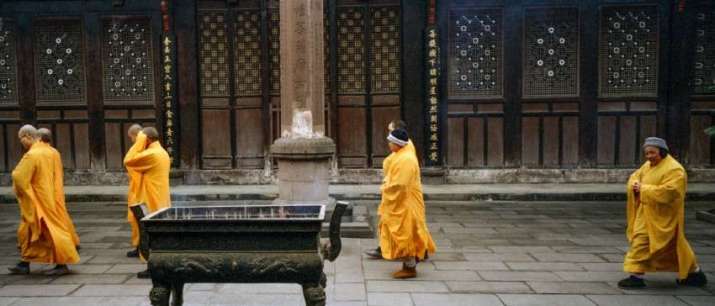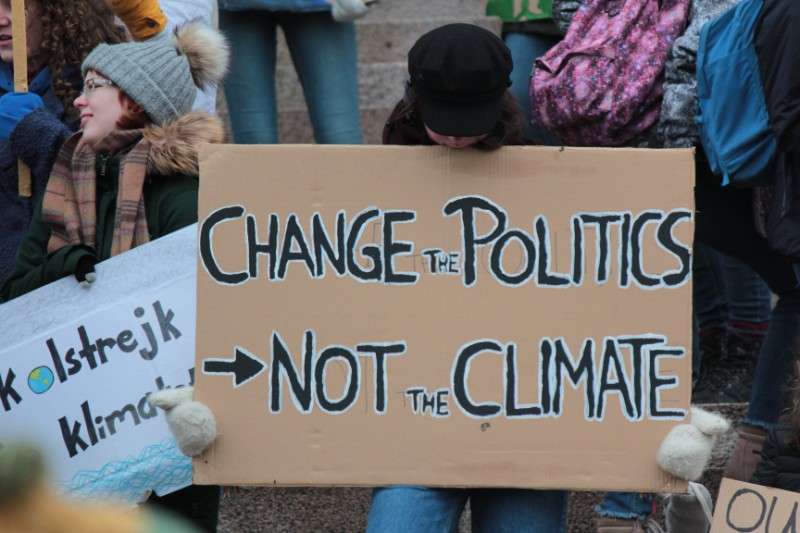
We are poised on the tipping point of the fourth technological revolution. For the privileged few, it appears as a brave new world of emerging digital and biological technologies, and they make it sound oh so seductive. But to most of the world’s inhabitants, we appear to be on a precipice above an inferno of unsustainable development. Climate despair, anticipatory grief, and feelings of helplessness are widespread. Societal stressors are fueling protest and conflict. The challenge of finding a way forward is complex and urgent. So what does the bodhisattva’s green practice path look like in the world of the near future?
As Zen master Thich Nhat Hanh said: “There is no way to happiness—happiness is the way.” It is a noble sentiment, but how do we actually map that to our engagement with the issues of the day? We see that in the Anthropocene, our unchecked human demand for economic growth casts a long, dark shadow, although some may choose to deny it.
Buddhist teachings on sufficiency and contentment stand in stark contrast to the prevailing global ideology of perpetual growth, resource extraction, and technologically mediated experiences. As a result, our relationship with the world we have created is very ambivalent. As Canadian philosopher Marshall McLuhan noted: “We create our tools; thereafter, they create us.” There is a momentum to what technology wants that makes it very difficult to change course.
There is no doubt that technology has brought great happiness to humans. Agri-tech has fed us all. Medi-tech has improved our health. Transpo-tech has enabled us to travel, to trade, and so on. The infrastructure of our cities sustains us. Scientific technologies enable us to learn about the natural world and not be powerless. Communications technologies connect us.
Our conundrum is that technology is also implicated in terrible injustices and tragedies: obscene riches for the one-per-centers, weapons of war, pollution, industrial accidents, climate change, mass extinctions. The list is long.
The information revolution has globalized, equalized, and harmonized us (except where governments prevent it), educating us in ways never before possible. We are history’s most knowledgeable generation. Yet the information revolution has also brought about new crimes and new problems. Again, the list is long.
So let’s be clear: nobody is willingly going to give up the benefits of technology. But we have to make a distinction here between appropriate technology and rampant consumerism, which is the belief that our sole path to happiness is through procurement and consumption of things and experiences (however “green”). Unbridled growth in our late-stage civilization is malignant. It is a fantasy to think that technology itself will provide us the ability to pull ourselves up by our bootstraps. Each step forward on that path comes with too much baggage.
We must look for happiness elsewhere, within ourselves and within intentional communities dedicated to sustainability and equality. This is the essence of renunciation. It is not a flight from life, but a credo for a higher calling. The Bodhisattva Vow to save all beings is not simply a romantic metaphor. We must accept our interbeing within the dynamic, co-creating biosphere we call Earth if we are to live within the limits to growth. There is work to be done and it starts when we get up off the cushion.

Buddhists are well acquainted with teachings on simple living, renunciation of materialism, and turning toward cultivation of the mind. The challenge, then, is to transform those from something individual into something societal: an idea that bodhisattvahood is congruent with good citizenship. Good citizenship, in this context, means supporting what’s best for plants and animals too, taking an activist stance against the status quo for better ways of being. We’ve got to make Buddhism less anthropocentric.
Perhaps in traditional Buddhist societies, monastic institutions provided such a progressive model and extended it into their communities. It may have been so, but that societal structure is dead and buried. The world doesn’t work like that now. The Zen masters are out in the marketplace, perforce, hawking their wares along with the rest of us. To make matters worse, since the monastic institutions of yore are no more, most Buddhist teachers are functioning in a precarious gig economy. The goal of Buddhist practice should not be to try and recreate the 12th century.
Can we be happy if our happiness comes at the expense of our children, our global community, and all the other living animals and plants upon whom we depend? Can we separate technologies that help us achieve the goal of sustainability from technologies that lead to mutually assured destruction? During the Zen boom of the 1960s and 1970s, it was all about each of us awakening to the now. In 1996, Stewart Brand, publisher of the world-changing Whole Earth Catalog in the 1960s, started the Long Now Foundation to promote foresight and strategic planning with a 10,000-year span. Can we focus on the shared Long Now of a Buddhist kalpa rather than the short-term personal moment?
Mindfulness is an aspect of Buddhist practice currently in vogue. Sadly, as Jeff Wilson recounts in his book, Mindful America (Oxford University Press 2014), it is often neutered, commodified, and subverted—no threat to the dominant cultural and economic paradigms. In Zen, that type of practice is known as bompu Zen—it’s concerned with health and individual well-being. Well and good, but we need something far more radical.

Paro, Bhutan
Many people say that fulfilment comes not from accumulating material things, or self-actualization, or even from attaining rarified mental states, but from a meaningful life helping others. World literature is full of stories of people who exemplify that truth. So let’s make it the starting point of our Great Vow, as the kingdom of Bhutan has done with their Gross National Happiness pledge.
We love to turn those game-changing figures such as Greta Thunberg into celebrities, and the bigger the number of people they help, the better they must be (or so the logic goes). It is as if you’re only a hero if you get a million “likes.” But that, too, is a limited perspective that lends itself to slacktivism. In the Buddhism of the future, enlightenment will be crowdsourced. Every one of us has a role to play.
We are natural designers and planners. We can make positive change. We can indeed set SMART goals—goals that are specific, measurable, attainable, realistic, and timely. And we can achieve them. Of course, we can’t, as individuals, solve all of the world’s problems, but we can each do something and together we are strong. To quote Arthur Ashe, the first black tennis player selected to the United States Davis Cup team: “Start where you are, use what you have, do what you can.”
References
Dunne, John and Daniel Goleman, ed. 2018. Ecology, Ethics, and Interdependence: The Dalai Lama in Conversation with Leading Thinkers on Climate Change. Somerville, MA: Wisdom Publications.
Harari, Yuval. 2018. 21 Lessons for the 21st Century. New York: Penguin Random House.
Kaza, Stephanie. 2019. Green Buddhism: Practice and Compassionate Action in Uncertain Times. Boulder, CO: Shambhala Publications.
Wilson, Jeff. 2014. Mindful America: The Mutual Transformation of Buddhist Meditation and American Culture. New York: Oxford University Press.
See more
The World in 2050 – The long view: how will the global economic order change by 2050?
The Intergovernmental Panel on Climate Change
The Long Now Foundation
Centre for Bhutan Studies & GNH
The Arthur Ashe Legacy
Glenn Wallis
The Effect of Economic Globalization on the Thai Buddhist Monks
Green Growth Knowledge Platform












